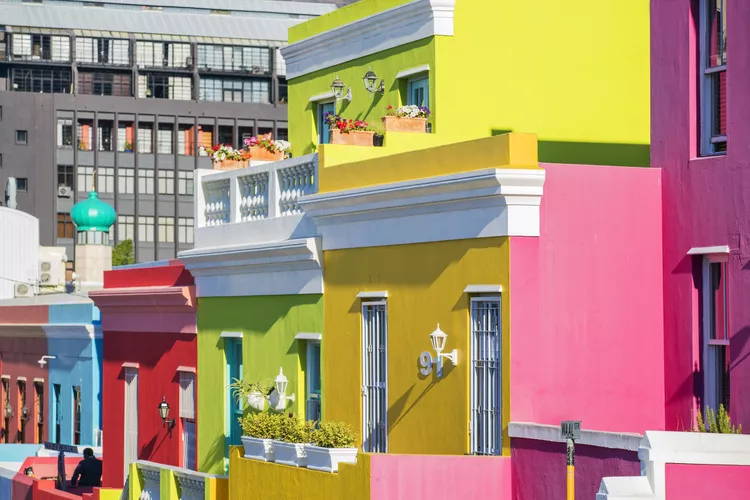Discovering Bo-Kaap: A Colorful Look into Cape Town’s History
1. Overview of Bo-Kaap’s Significance
2. Historical Background of Bo-Kaap
3. Activities and Attractions in Bo-Kaap
4. Flavorful Cape Malay Cuisine
5. Visiting Bo-Kaap: Tips for Travelers
6. Practical Information for Your Visit
Overview of Bo-Kaap’s Significance
Situated between Cape Town city center and the foothills of Signal Hill, Bo-Kaap translates from Afrikaans to mean “above the Cape”. Today, it’s renowned as one of the most Instagrammable locations in South Africa, thanks to its vibrant, pastel-colored houses and charming cobbled streets. Moreover, Bo-Kaap is one of the oldest and most historic residential neighborhoods in Cape Town, deeply intertwined with the Islamic Cape Malay culture, evident through its halal restaurants and the resonating call to prayer from local mosques.
Historical Background of Bo-Kaap
The Bo-Kaap neighborhood was established in the 1760s by Dutch colonialist Jan de Waal, who constructed small rental homes for Cape Malay slaves. These people, originating from the Dutch East Indies (including Malaysia, Singapore, and Indonesia), were forcibly brought to the Cape as slaves in the late 17th century. While some were convicts, others were political prisoners from influential families, with nearly all practicing Islam.
Legend has it that de Waal’s rental agreements required the homes to remain white. Following the abolition of slavery in 1834, many of the new homeowners chose to paint their houses in vivid colors as a declaration of their freedom. Originally named Waalendorp, Bo-Kaap transitioned into the Malay Quarter, where Islamic traditions became central to the community’s identity, fostering a rich cultural heritage as many residents were skilled artisans.
Activities and Attractions in Bo-Kaap
There’s a wealth of attractions in Bo-Kaap. Visitors are drawn to its stunning color palette and distinctive Cape Dutch and Cape Georgian architecture. The oldest building in the neighborhood, constructed by Jan de Waal in 1768, now houses the Bo-Kaap Museum. This museum, designed to resemble a wealthy 19th-century Cape Malay family home, gives valuable insight into the lives of early settlers and the impact of Islamic traditions on Cape Town’s culture and arts.
The local Muslim heritage is represented by numerous mosques, including the historic Auwal Mosque on Dorp Street, built in 1794—making it the oldest mosque in South Africa. Auwal Mosque is famous for housing a handwritten Quran by Tuan Guru, the mosque’s first imam, created during his imprisonment on Robben Island. The Tana Baru Cemetery in Bo-Kaap is also notable, as it was the first land designated for Muslims following the granting of religious freedom in 1804.
Flavorful Cape Malay Cuisine
After enjoying Bo-Kaap’s historic sites, be sure to indulge in its captivating Cape Malay cuisine, a remarkable fusion of Middle Eastern, Southeast Asian, and Dutch culinary traditions. The area’s cooking features a vibrant use of fruits and spices, offering fragrant curries, rootis, and samoosas available from street vendors and restaurants. At eateries like Bo-Kaap Kombuis and Biesmiellah, staples such as denningvleis and bobotie (often considered South Africa’s unofficial national dish) can be savored. For dessert, try a koeksister—a spiced donut immersed in syrup and sprinkled with coconut.
If you wish to recreate these flavors at home, visit the largest spice shop in the area, Atlas Spices. However, remember that traditional restaurants in Bo-Kaap are halal and do not serve alcohol. Conclude your meals with one of South Africa’s delightful non-alcoholic beverages, and you may choose to later sample some of the region’s renowned wines elsewhere in the city.
Visiting Bo-Kaap: Tips for Travelers
Bo-Kaap is accessible and safe for visitors, located just a five-minute walk from the city center and a 10-minute drive from the V&A Waterfront—the main tourist hub. To reach the heart of Bo-Kaap, a leisurely stroll along Wale Street will lead you to the Bo-Kaap Museum. After your museum visit, take time to explore the picturesque side streets nearby. For a more informative experience, consider downloading an audio walking tour narrated by a local, Shereen Habib, to learn about top attractions in the area.
For those who prefer guided experiences, numerous walking tours are available. Free Walking Tours Cape Town offers a popular free walking tour that includes essential highlights such as Auwal Mosque, Biesmiellah, and Atlas Spices. Additionally, some tours, like the one by Cape Fusion Tours, provide an opportunity to engage in a cooking class led by local women in their homes, allowing for a deeper understanding of modern Islamic life in Cape Town.
Practical Information for Your Visit
The Bo-Kaap Museum operates from 9:00 am to 4:00 pm from Mondays to Saturdays, closed on certain public holidays. An entrance fee of R20 for adults and R10 for children aged six to seventeen is applicable, with free entry for kids under five. The Tana Baru Cemetery welcomes visitors daily from 9:00 am to 6:00 pm. For accommodation, Rouge on Rose is recommended. Located just a four-minute walk from the museum, it boasts stunning views of Lion’s Head, exceptional service, and made-to-order breakfasts.
Top Tips
When exploring Bo-Kaap independently, keep in mind that it is safest during daylight hours. If your visit extends into the evening, opt for a taxi or travel in a group. For women, conservative dressing is advisable in Bo-Kaap, in accordance with Muslim cultural norms. Specifically, garments should cover your chest, legs, and shoulders when entering mosques, and carrying a headscarf is wise.




